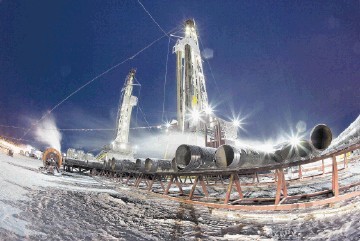
Argentina is depending on two things to reverse a three-year energy shortfall that’s costing $6 billion a year: a shale formation bigger than Massachusetts and Miguel Galuccio, who has worked on drilling operations from North Dakota to Poland and India.
President Cristina Fernandez de Kirchner appointed Galuccio chief executive officer of YPF SA (YPF) in 2012 after she seized control from Spain’s Repsol SA.
Since then, Galuccio has tripled investment in the state-run oil company in an effort to reverse a decline in output that’s led to crippling energy shortages and drove Argentina’s energy imports to record highs.
As oil prices plunge below $60 a barrel and global producers revise their spending, Galuccio is sticking with a strategy for the Vaca Muerta shale formation that relies on foreign partners with a long-term view.
His $16 billion Loma Campana venture with Chevron Corp. is Argentina’s second-largest producer and YPF announced this month a $550 million partnership with Malaysia’s Petrolian Nasional Bhd.
“It’s a huge achievement for Argentina, in two years to have a showcase like Loma Campana,” the 46-year-old Galuccio said in an interview. “It’s not a Mickey Mouse showcase.”
As the price of oil continues to drop, others aren’t so sure.
Cheap crude will “result in less aggressive development of Vaca Muerta,” said Paolo Rocca, the billionaire chairman of oil-pipe supplier Tenaris SA, at an industry supplier conference in Buenos Aires on December 10.
Billionaire fund managers George Soros, Daniel Loeb and Richard Perry all reduced their holdings in YPF stakes in the third quarter as oil slumped. Deutsche Bank AG cut its recommendation to hold from buy on December 9.
YPF first identified Vaca Muerta beneath the plains of Patagonia in the 1980s, and it holds at least 23 billion barrels of oil, according to a 2012 survey by Ryder Scott.
At 30,000 square kilometers, it’s almost twice the size of the Eagle Ford shale formation in Texas, which produces more than 1.6 million barrels a day.
Since Argentina seized a 51% stake in the company in April 2012, YPF has sold more than $1.7 billion of securities abroad. Its shares have surged 120%, compared with a 21% decline for an index of international oil stocks.
Extracting Vaca Muerta’s reserves from almost 3 kilometers (1.8 miles) down is key for Argentina to once again become an energy exporter, according to Galuccio, a former Schlumberger Ltd. executive who winds down with boxing, hot yoga and polo in his free time.
Executives who visit the Loma Campana joint venture walk away willing to see YPF as a partner, he said.
That’s important since the 2012 nationalization of YPF gave the world’s energy companies a good reason to be wary of investing in Argentina.
At the Loma Campana venture with Chevron, 40-meter (131-foot) walking rigs delivered from Houston puncture the dry terrain in Neuquen province.
It’s the biggest shale field outside of the US, pumping 35,000 barrels a day, and production is set to rise as YPF turns to horizontal drilling.
Galuccio has also signed up other companies to work in the Vaca Muerta. Dow Chemical Co., based in Midland, Michigan, is developing gas in an area called El Orejano and Malaysia’s state-own Petronas agreed December 10 to work with YPF to drill at an 187-square-kilometer site known as La Amarga Chica.
“Having that measured reservoir of 23 billion barrels of oil equivalent sure helps in raising your profile,” said Michael Roche, a strategist at Seaport Global Holdings LLC, in an interview.
YPF will benefit from working with “world-leading oil companies,” he said, calling it a positive “testimony to the government’s decision to go with an oil veteran.”
The relationship between Galuccio and the Argentine president is helpful to both.
Since nationalizing YPF, Fernandez aided the oil industry by reducing taxes and allowing higher pump prices that let energy companies remain profitable even with an estimated 40% inflation rate.
Now, she’s betting a new hydrocarbons law that gives producers higher prices and tax incentives for shale operations will see Argentina regain self-sufficiency in energy by 2019.
As a result, Galuccio said, it “probably reasonable” for Argentina to become a net exporter within 10 years.
“I don’t get overexcited when the price jumps and neither depressed when it goes down in the short term,” he said from his office in Puerto Madero, which was built by Repsol in the plush business district just footsteps away from the presidential palace in Buenos Aires.
“I don’t believe in long-term $50 or $70,” he said. “With $80, we’ll be OK. If it’s $70, we’ll have to become more competitive. We have a lot of room for productivity.”
Recommended for you
